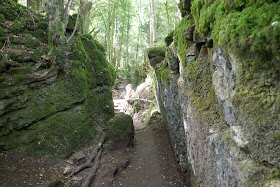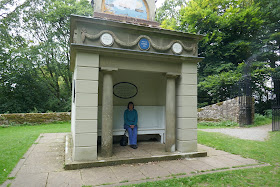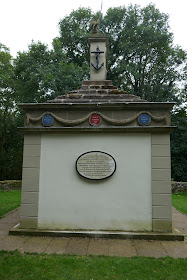An Unusual Wood and a Gentleman's Picnic House Above the River Wye
Puzzlewood
 |
| Gloucestershire |
 |
| Forest of Dean |
The owners are developing Puzzlewood as a family attraction, but we felt we could ignore the play area and the farm animals, though I could not resist a photo of a chicken – a silkie, I believe, originally a native of China.
 |
| A silkie at Puzzlewood |
The wood itself is a remarkable landscape; a confusion of boulders, trees and twisted roots, covered with a rain-forest thick layer of moss. We followed the forest paths, which divided and then looped back on themselves and then divided again.
 |
| Puzzlewood |
Navigation was a minor puzzle and there are no maps but the fields on the far side are only 300m away, and if we walked further than that to get there, we were usually going in the right direction.
 |
| Puzzlewood and a 'rickety bridge' |
There are fairy doors, and rickety bridges (though more firmly constructed than they are made to look) and places to pause and access the Puzzlewood app – provided your phone (unlike ours) has the right operating system - but what makes the landscape unique to the Forest of Dean and unusual even within it are the scowles.
 |
| Scowle, Puzzlewood |
Scowles are labyrinthine defiles several metres deep, though in many places the sides have been eroded into discrete blocks of stone.
 |
| An eroded scowle |
Long thought to be the remnants of iron-age open-cast iron ore extraction, geologist now believe them to be natural features, though enlarged and exploited by mining activity.
A Gloucester County Council archaeological information sheet entitled The Scowles of the Forest of Dean suggests the present view is that they originated as a natural underground cave system which formed in the Carboniferous Limestones of the Forest of Dean many millions of years ago. Uplift and erosion eventually caused this cave system to become exposed at the surface. The exposed caves were rich in iron ore were easy pickings for the earliest miners and their work and further erosion produced the landscape we see today.
 |
| Lynne plods up through another scowle |
Our daughter had been right, Puzzlewood is well worth a visit and we spent over an hour wandering round in the wood. Returning to the café we drank cappuccinos (cappuccini?) beneath a sizeable sword. Looking closer, I learned that it was made of Valyrian steel and was formerly the property of Eddard Stark.
 |
| The Valyrian steel sword known as Ice wielded by Eddard Stark (allegedly) |
I am not aware of Puzzlewood being a location in Game of Thrones, but it does feature in Star Wars: The Force Awakens, four separate episodes of Dr Who, two episodes of Merlin and the BBC’s 2016 adaptation of A Midsummer Night's Dream. JRR Tolkien was a frequent visitor and used the wood as a template for some of Middle Earth’s Forests, and maybe Harry Potter’s ‘Forbidden Forest’ is also a relative.
The Kymin
 |
| Monmouthshire |
 |
| Wales |
We were still a mile or two short of Monmouth when we passed a Croeso i Gymru sign; we had entered our ancestral homeland but were still east of the Wye. I had always believed the border ran along the River Monnow to its confluence with the Wye and then down the Wye to the coast, but not so - for reasons known only to long dead cartographers there is a fun-sized chunk of Wales on the wrong side of the Wye opposite Monmouth.
 |
| Always a welcome sight to the exile |
Having left the Forest of Dean, in political fact if not quite in spirit, we turned off the main road, following the National Trust signs to The Kymin. The road, narrow with the occassional hairpin, climbed steadily from the Wye Valley to a viewpoint 250m above the river.
In the late 18th /early 19th centuries "the principal Gentlemen of Monmouth and its vicinity" formed the Monmouth Picnic Club or Kymin Club (from the Welsh Cae y Maen – Field of Stones) "for the purpose of dining together, and spending the day in a social and friendly manner". Everyone enjoys a picnic in good weather, but the Monmouthshire weather gods are a fickle bunch, so Philip Meakins Hardwick suggested building a roundhouse for "security from the inclemency of the weather". The members, headed by the Duke of Beaufort and 8 MPs paid subscriptions and building started in 1794.
 |
| The Kymin |
The Kymin, as it became known, had kitchens on the ground-floor and a banqueting room above. The view is spectacular and the banqueting room was – and still is - equipped with a telescope. In time the club ran out of steam and eventually the building became a dwelling. That ceased in the early 20th century when the roundhouse was restored and duly found its way into the care of the National Trust.
 |
| Banqueting Room, The Kymin |
The view is variously said to encompass nine or ten counties. Monmouth is a long way down beside the river and a great deal of effort would be required to drag a picnic/banquet all this way. I doubt that troubled the members, they had servants for that sort of thing and all they had to do was trot up on their nags – a little more effort than my driving up, but they could park closer to the house.
 |
| Monmouth and the Wye Valley from the Kymin |
The Naval Temple
In 1800, to commemorate the second anniversary of Nelson’s victory at the Battle of the Nile and in recognition of the victories of fifteen other Royal Navy Admirals, the Kymin Club built The Naval Temple.
 |
| Tne Naval Temple, The Kymin |
This was the early days of tourism; the Wye Valley was prime tourist country and Nelson himself came floating down the river with Lady Hamilton and her husband Sir William Hamilton (as a prize gooseberry). Nelson was greeted by a cannonade and the band of the Monmouthshire Militia playing See, the Conquering Hero Comes (they don’t do that for tourists these days, or was it just me?). During his brief stay in Monmouth, Nelson breakfasted at the roundhouse and visited the Naval Temple of which he said "it was the only monument of its kind erected to the Royal Navy in the Kingdom," which was diplomatic. Others have been more forthright, ‘In very bad taste,’ said antiquarian, archaeologist and artist Sir Richard Colt Hoare in 1803 while architectural historian John Newman has described it as ‘hard to come to terms with.’ And this retired maths teacher and artistic ignoramus agrees with Hoare and Newman - and no doubt he will find that a great relief.
 |
| Naval Temple, The Kymin |
[Afterthought: November 2019] Being in Wales all the signs were bilingual. It might be worth mentioning that Welsh was the main language of the Forest of Dean until the 9th century, ‘scowles’ probably deriving from the Welsh ‘ysgil’ meaning ‘a recess’. If the English electorate support Boris Johnson’s plan to break up the United Kingdom, then Wales will probably cling on to England like Montenegro clung to Serbia, but in the end it will go. And then maybe we will want our forest back.
And so we left the Kymin and headed home.
No comments:
Post a Comment